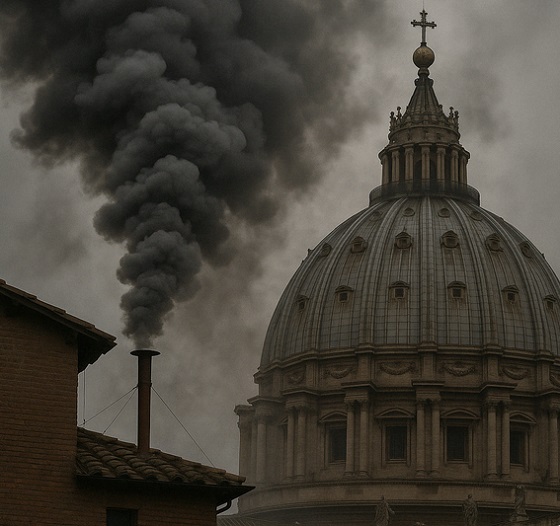Alberta
Heavy-duty truckers welcome new ‘natural gas highway’ in Alberta

Clean Energy Fuels CEO Andrew Littlefair, Tourmaline CEO Mike Rose, and Mullen Group chairman Murray Mullen attend the opening of a new Clean Energy/Tourmaline compressed natural gas (CNG) fuelling station in Calgary on Oct. 22, 2024. Photo courtesy Tourmaline
From the Canadian Energy Centre
New compressed natural gas fueling stations in Grande Prairie and Calgary join new stop in Edmonton
Heavy-duty truckers hauling everything from restaurant supplies to specialized oilfield services along one of Western Canada’s busiest corridors now have more access to a fuel that can help reduce emissions and save costs.
Two new fuelling stations serving compressed natural gas (CNG) rather than diesel in Grande Prairie and Calgary, along with a stop that opened in Edmonton last year, create the first phase of what proponents call a “natural gas highway”.
“Compressed natural gas is viable, it’s competitive and it’s good for the environment,” said Murray Mullen, chair of Mullen Group, which operates more than 4,300 trucks and thousands of pieces of equipment supporting Western Canada’s energy industry.
Right now, the company is running 19 CNG units and plans to deploy another 15 as they become available.
“They’re running the highways right now and they’re performing exceptionally well,” Mullen said on Oct. 22 during the ribbon-cutting ceremony opening the new station on the northern edge of Calgary along Highway 2.
“Our people love them, our customers love them and I think it’s going to be the way for the future to be honest,” he said.
 Heavy-duty trucks at Tourmaline and Clean Energy’s new Calgary compressed natural gas fuelling station. Photo courtesy Tourmaline
Heavy-duty trucks at Tourmaline and Clean Energy’s new Calgary compressed natural gas fuelling station. Photo courtesy Tourmaline
According to Natural Resources Canada, natural gas burns more cleanly than gasoline or diesel fuel, producing fewer toxic pollutants and greenhouse gas emissions that contribute to climate change.
The two new CNG stops are part of a $70 million partnership announced last year between major Canadian natural gas producer Tourmaline and California-based Clean Energy Fuels.
Their deal would see up to 20 new CNG stations built in Western Canada over the next five years, daily filling up to 3,000 natural gas-fueled trucks.
One of North America’s biggest trucking suppliers to businesses including McDonald’s, Pizza Hut, Subway and Popeye’s says the new stations will help as it expands its fleet of CNG-powered vehicles across Canada.
Amy Senter, global vice-president of sustainability with Illinois-based Martin Brower, said in a statement that using more CNG is critical to the company achieving its emissions reduction targets.
For Tourmaline, delivering CNG to heavy-duty truckers builds on its multi-year program to displace diesel in its operations, primarily by switching drilling equipment to run on natural gas.
Between 2018 and 2022, the company displaced the equivalent of 36 Olympic-sized swimming pools worth of diesel that didn’t get used, or the equivalent emissions of about 58,000 passenger vehicles.
 Tourmaline CEO Mike Rose speaks to reporters during the opening of a new Tourmaline/Clean Energy compressed natural gas fuelling station in Calgary on Oct. 22, 2024. Photo courtesy Tourmaline
Tourmaline CEO Mike Rose speaks to reporters during the opening of a new Tourmaline/Clean Energy compressed natural gas fuelling station in Calgary on Oct. 22, 2024. Photo courtesy Tourmaline
Tourmaline CEO Mike Rose noted that the trucking sector switching fuel from diesel to natural gas is gaining momentum, notably in Asia.
A “small but growing” share of China’s trucking fleet moving to natural gas helped drive an 11 percent reduction in overall diesel consumption this June compared to the previous year, according to the latest data from the U.S. Energy Information Administration.
“China’s talking about 30 percent of the trucks sold going forward are to be CNG trucks, and it’s all about reducing emissions,” Rose said.
“It’s one global atmosphere. We’re going to reduce them here; they’re going to reduce them there and everybody’s a net winner.”
Switching from diesel to CNG is “extremely cost competitive” for trucking fleets, said Clean Energy CEO Andrew Littlefair.
“It will really move the big rigs that we need in Western Canada for the long distance and heavy loads,” he said.
Tourmaline and Clean Energy aim to have seven CNG fuelling stations operating by the end of 2025. Construction is set to begin in Kamloops, B.C., followed by Fort McMurray and Fort St. John.
“You’ll have that Western Canadian corridor, and then we’ll grow it from there,” Littlefair said.
Alberta
Red Deer Justice Centre Grand Opening: Building access to justice for Albertans

The new Red Deer Justice Centre will help Albertans resolve their legal matters faster.
Albertans deserve to have access to a fair, accessible and transparent justice system. Modernizing Alberta’s courthouse infrastructure will help make sure Alberta’s justice system runs efficiently and meets the needs of the province’s growing population.
Alberta’s government has invested $191 million to build the new Red Deer Justice Centre, increasing the number of courtrooms from eight to 12, allowing more cases to be heard at one time.
“Modern, accessible courthouses and streamlined services not only strengthen our justice
system – they build safer, stronger communities across the province. Investing in the new Red Deer Justice Centre is vital to helping our justice system operate more efficiently, and will give people in Red Deer and across central Alberta better access to justice.”

Government of Alberta and Judiciary representatives with special guests at the Red Deer Justice Centre plaque unveiling event April 22, 2025.
On March 3, all court services in Red Deer began operating out of the new justice centre. The new justice centre has 12 courtrooms fully built and equipped with video-conference equipment to allow witnesses to attend remotely if they cannot travel, and vulnerable witnesses to testify from outside the courtroom.
The new justice centre also has spaces for people taking alternative approaches to the traditional courtroom trial process, with the three new suites for judicial dispute resolution services, a specific suite for other dispute resolution services, such as family mediation and civil mediation, and a new Indigenous courtroom with dedicated venting for smudging purposes.
“We are very excited about this new courthouse for central Alberta. Investing in the places where people seek justice shows respect for the rights of all Albertans. The Red Deer Justice Centre fills a significant infrastructure need for this rapidly growing part of the province. It is also an important symbol of the rule of law, meaning that none of us are above the law, and there is an independent judiciary to decide disputes. This is essential for a healthy functioning democracy.”
“Public safety and access to justice go hand in hand. With this investment in the new Red Deer Justice Centre, Alberta’s government is ensuring that communities are safer, legal matters are resolved more efficiently and all Albertans get the support they need.”
“This state-of-the-art facility will serve the people of Red Deer and surrounding communities for generations. Our team at Infrastructure is incredibly proud of the work done to plan, design and build this project. I want to thank everyone, at all levels, who helped make this project a reality.”
Budget 2025 is meeting the challenge faced by Alberta with continued investments in education and health, lower taxes for families and a focus on the economy.

Quick facts
- The new Red Deer Justice Centre is 312,000 sq ft (29,000 m2). (The old courthouse is 98,780 sq ft (9,177 m2)).
- The approved project funding for the Red Deer Justice Centre is about $191 million.
Alberta
CPP another example of Albertans’ outsized contribution to Canada

From the Fraser Institute
By Tegan Hill
Amid the economic uncertainty fuelled by Trump’s trade war, its perhaps more important than ever to understand Alberta’s crucial role in the federation and its outsized contribution to programs such as the Canada Pension Plan (CPP).
From 1981 to 2022, Albertan’s net contribution to the CPP—meaning the amount Albertans paid into the program over and above what retirees in Alberta received in CPP payments—was $53.6 billion. In 2022 (the latest year of available data), Albertans’ net contribution to the CPP was $3.0 billion.
During that same period (1981 to 2022), British Columbia was the only other province where residents paid more into the CPP than retirees received in benefits—and Alberta’s contribution was six times greater than B.C.’s contribution. Put differently, residents in seven out of the nine provinces that participate in the CPP (Quebec has its own plan) receive more back in benefits than they contribute to the program.
Albertans pay an outsized contribution to federal and national programs, including the CPP because of the province’s relatively high rates of employment, higher average incomes and younger population (i.e. more workers pay into the CPP and less retirees take from it).
Put simply, Albertan workers have been helping fund the retirement of Canadians from coast to coast for decades, and without Alberta, the CPP would look much different.
How different?
If Alberta withdrew from the CPP and established its own standalone provincial pension plan, Alberta workers would receive the same retirement benefits but at a lower cost (i.e. lower CPP contribution rate deducted from our paycheques) than other Canadians, while the contribution rate—essentially the CPP tax rate—to fund the program would likely need to increase for the rest of the country to maintain the same benefits.
And given current demographic projections, immigration patterns and Alberta’s long history of leading the provinces in economic growth, Albertan workers will likely continue to pay more into the CPP than Albertan retirees get back from it.
Therefore, considering Alberta’s crucial role in national programs, the next federal government—whoever that may be—should undo and prevent policies that negatively impact the province and Albertans ability to contribute to Canada. Think of Bill C-69 (which imposes complex, uncertain and onerous review requirements on major energy projects), Bill C-48 (which bans large oil tankers off B.C.’s northern coast and limits access to Asian markets), an arbitrary cap on oil and gas emissions, numerous other “net-zero” targets, and so on.
Canada faces serious economic challenges, including a trade war with the United States. In times like this, it’s important to remember Alberta’s crucial role in the federation and the outsized contributions of Alberta workers to the wellbeing of Canadians across the country.
-

 2025 Federal Election2 days ago
2025 Federal Election2 days agoStudy links B.C.’s drug policies to more overdoses, but researchers urge caution
-

 2025 Federal Election2 days ago
2025 Federal Election2 days agoConservatives promise to ban firing of Canadian federal workers based on COVID jab status
-

 International2 days ago
International2 days agoPope Francis Got Canadian History Wrong
-

 Business2 days ago
Business2 days agoIs Government Inflation Reporting Accurate?
-

 2025 Federal Election2 days ago
2025 Federal Election2 days agoCarney’s Hidden Climate Finance Agenda
-

 2025 Federal Election2 days ago
2025 Federal Election2 days agoWhen it comes to pipelines, Carney’s words flow both ways
-

 Environment2 days ago
Environment2 days agoExperiments to dim sunlight will soon be approved by UK government: report
-

 Censorship Industrial Complex2 days ago
Censorship Industrial Complex2 days agoIs free speech over in the UK? Government censorship reaches frightening new levels





